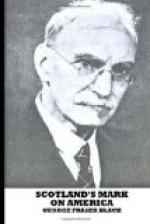typographically far surpassed any paper that had appeared
before it in New England.” David Hall (c.
1714-1772), born in Edinburgh, emigrated to America
shortly after 1740, became a partner of Benjamin Franklin
in 1748. He was printer of the Pennsylvania
Gazette, one of the few leading newspapers of
the day, and one of the founders of the St. Andrew’s
Society of Philadelphia. His son, William (died
1831), who carried on the printing business, was one
of the original members of the “Light Horse
of the City of Philadelphia,” afterwards known
as “The First City Troop,” and served
in the Continental Army during the Revolutionary War.
Robert Aitken (1734-1802), born in Dalkeith, Scotland,
printer and publisher in Philadelphia in 1769, was
publisher of the Pennsylvania Magazine from
January 1775 to June 1776, the first magazine in Philadelphia
containing illustrations, most of which were engraved
by Aitken himself. He also published, at his own
expense, in 1782, the first English Bible printed in
America. Major Andrew Brown (c. 1744-1797), born
in the north of Ireland of Scottish parents, was publisher
of the Federal Gazette, later (1793) changed
to Philadelphia Gazette. He is credited
with being the first newspaper man to employ a reporter
for the debates in Congress. It may here be mentioned
that the publisher of the first directory of Philadelphia
and its suburbs (1782), was a Scot, Captain John Macpherson
(1726-92). James Adams, Delaware’s first
printer (1761), was an Ulster Scot who learned the
art of printing in Londonderry and founded the Wilmington
Courant in 1762. Col. Eleazer Oswald
(1755-1795), of Scottish origin, though born in England,
rendered brilliant service on the side of the colonies
during the Revolution. In 1779 he became associated
with William Goddard in the Maryland Journal,
the first newspaper printed in Baltimore. Later
removing to Philadelphia he issued the first number
of the Independent Gazetteer, or the Chronicle
of Freedom, April 13, 1782, and at the same time
he also conducted in New York The Independent Gazetteer,
or New York Journal (1782-87). The first
daily paper published in Baltimore (1791) was by David
Graham. Alexander Purdie, a native of Scotland,
was editor of the Virginia Gazette from March
1766 to December 1774. Shortly after this date
he started a Gazette of his own, and in the issue
of his paper for June 7, 1776, he printed the heraldic
device of a shield, on which is a rattlesnake coiled,
with supporters, dexter, a bear collared and chained,
sinister, a stag. The crest is a woman’s
head crowned and the motto: Don’t tread
on me. Adam Boyd (1738-1803), colonial printer
and preacher, purchased the printing outfit of another
Scot, Andrew Stuart, who had set up the first printing
press in Wilmington, North Carolina, in 1763.
In 1769 (Oct. 13) Boyd issued the first number of
the Cape Fear Mercury, and continued it till




